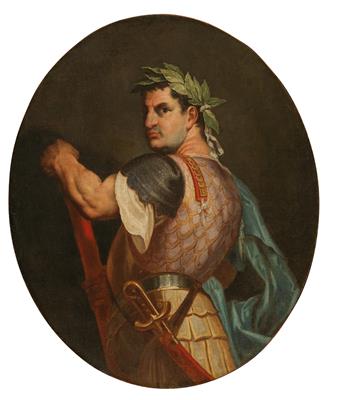Flemish School, circa 1600

The Emperor Titus (39–81 AD),
oil on canvas, oval, 130 x 108 cm, unframed
The present work is an enduring testament to the monumental influence of Titian’s (1490–1576) history painting on later generations of Flemish artists, and of the ongoing exchange between the artistic centres of Antwerp and Venice, along with its key ally, Mantua through the sixteenth and seventeenth centuries. The present depiction of Titus Vespasian (39–81 AD), an Emperor of the Flavian dynasty who ruled for a mere two years, but completed the construction of the Colosseum, is taken from Titian’s Eleven Caesars executed 1536–40, for Federico II Gonzaga, Duke of Mantua (1500–1540). This highly influential series of paintings were hung in the Camerino dei Cesari in the Ducal Palace, and indeed were still in situ in 1601 when Peter Paul Rubens was appointed court artist in Mantua by Federico’s grandson, Vincenzo I Gonzaga (1562–1612). Although only nine depictions of Emperors by Rubens are recorded, and these seem to be as inspired by original antique sculptural busts as much as by Titian’s lost works, Rubens’s series originally must have included 12 paintings, in keeping with the 12 descriptions contained in the popular re-prints of De Vita Caesarum by Gaius Suetonius Tranquillus (70–130 A.D.)
The present canvas is one of the few remaining painted ricordi of Titian’s series by an as yet unidentified, but accomplished, Flemish hand, while fellow Fleming Aegidius Sadeler the Younger (1570–1629) also engraved the series (Hollstein XXI.77.357), presumably after drawings he made of them in Mantua en route to Rome in 1593. Titian’s original paintings were sold to Charles I of England as part of the Mantua Purchase in 1626 along with masterpieces by Raphael, Correggio and Mantegna, of which only Mantegna’s Triumphs of Caesar still remains in the Royal Collection. Following Charles I’s execution, the Eleven Caesars were bought by the Spanish Royal collection, where they perished in a fire that destroyed the Alcazar of Madrid in 1734.
Expert: Damian Brenninkmeyer
 Damian Brenninkmeyer
Damian Brenninkmeyer
+43 1 515 60 403
oldmasters@dorotheum.com
09.06.2021 - 16:06
- Dosažená cena: **
-
EUR 19.985,-
- Odhadní cena:
-
EUR 18.000,- do EUR 30.000,-
Flemish School, circa 1600
The Emperor Titus (39–81 AD),
oil on canvas, oval, 130 x 108 cm, unframed
The present work is an enduring testament to the monumental influence of Titian’s (1490–1576) history painting on later generations of Flemish artists, and of the ongoing exchange between the artistic centres of Antwerp and Venice, along with its key ally, Mantua through the sixteenth and seventeenth centuries. The present depiction of Titus Vespasian (39–81 AD), an Emperor of the Flavian dynasty who ruled for a mere two years, but completed the construction of the Colosseum, is taken from Titian’s Eleven Caesars executed 1536–40, for Federico II Gonzaga, Duke of Mantua (1500–1540). This highly influential series of paintings were hung in the Camerino dei Cesari in the Ducal Palace, and indeed were still in situ in 1601 when Peter Paul Rubens was appointed court artist in Mantua by Federico’s grandson, Vincenzo I Gonzaga (1562–1612). Although only nine depictions of Emperors by Rubens are recorded, and these seem to be as inspired by original antique sculptural busts as much as by Titian’s lost works, Rubens’s series originally must have included 12 paintings, in keeping with the 12 descriptions contained in the popular re-prints of De Vita Caesarum by Gaius Suetonius Tranquillus (70–130 A.D.)
The present canvas is one of the few remaining painted ricordi of Titian’s series by an as yet unidentified, but accomplished, Flemish hand, while fellow Fleming Aegidius Sadeler the Younger (1570–1629) also engraved the series (Hollstein XXI.77.357), presumably after drawings he made of them in Mantua en route to Rome in 1593. Titian’s original paintings were sold to Charles I of England as part of the Mantua Purchase in 1626 along with masterpieces by Raphael, Correggio and Mantegna, of which only Mantegna’s Triumphs of Caesar still remains in the Royal Collection. Following Charles I’s execution, the Eleven Caesars were bought by the Spanish Royal collection, where they perished in a fire that destroyed the Alcazar of Madrid in 1734.
Expert: Damian Brenninkmeyer
 Damian Brenninkmeyer
Damian Brenninkmeyer
+43 1 515 60 403
oldmasters@dorotheum.com
|
Horká linka kupujících
Po-Pá: 10.00 - 17.00
old.masters@dorotheum.at +43 1 515 60 403 |
| Aukce: | Obrazy starých mistrů II |
| Typ aukce: | Online aukce |
| Datum: | 09.06.2021 - 16:06 |
| Místo konání aukce: | Wien | Palais Dorotheum |
| Prohlídka: | 29.05. - 08.06.2021 |
** Kupní cena vč. poplatku kupujícího a DPH
Není již možné podávat příkazy ke koupi přes internet. Aukce se právě připravuje resp. byla již uskutečněna.
